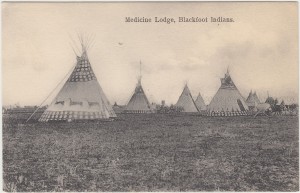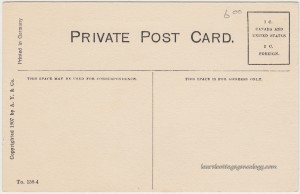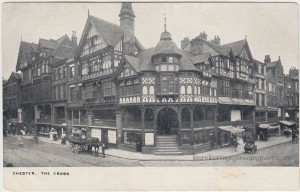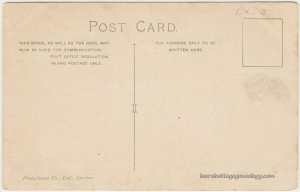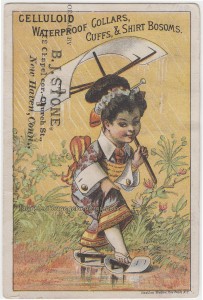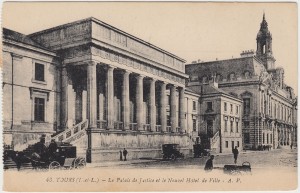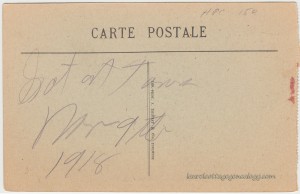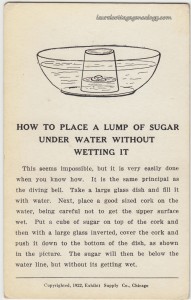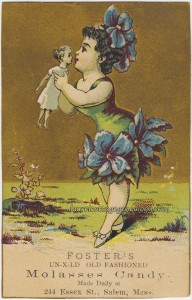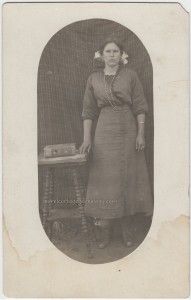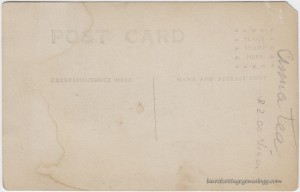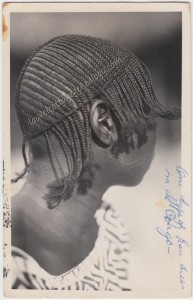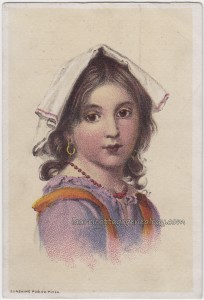

A charming drawing of a rosy-cheeked girl wearing what seems to be a handkerchief for a head-covering. Published by the Sunshine Publishing Company of Philadelphia. The flip side shows that this is sort of a playbill type of trade card for the play “Garry Owen” starring the “Famous Irish-American comedian and vocalist Barry Conlan as Shaun O’Reilly.” According to The New York Clipper Annual, this play, also called “Labor, Land and Liberty,” first appeared at the Academy of Music, Chicago in May 1883. The Academy of Music was leased by Daniel Shelby in about 1881, according to The History of Chicago, Volume 3, but Shelby is listed on the card as sole proprietor, so possibly meaning it was just the building that was leased, and he was sole proprietor of the production company. Daniel Shelby (Daniel is written as “Dan’l” on this trade card and also in the History of Chicago book) had a long and varied career in the entertainment business as singer, actor, circus clown and tumbler, manager and proprietor. Born Daniel Macher January 11, 1838 in Gettysburg, PA, Daniel moved with his family, before his first birthday, to Dayton, OH. At age fourteen, he was already popular with the locals as a balladist. When a traveling minstrel show (Sam Wells’ minstrels) came to town he got his shot on a professional stage and promptly joined up with that company.
Marriage, etc: Daniel was married twice. His first marriage shows him as Daniel J. Macher, marrying Agnes Blanche Cartland, March 12, 1874 in Buffalo, NY. They had one son, Roy Daniel, born April 2, 1876, who sadly, died young, July 4, 1881 in Chicago, at the age of five. The 1880 Federal census for Buffalo, NY shows the family under the last name of Shelby, so it seems that Dan changed his last name sometime after his marriage to Agnes in 1871 and before the 1880 census. His occupation is listed there as “theatrical manager.” Daniel Shelby married Nellie Hatfield Pennock of Altoona, PA on March 23, 1882. Nellie was an opera singer and prima donna, and went by the stage name of Helen Rainsley. Nellie and Dan had two children, Daniel, born January 9, 1883 in Chicago, and Medinah Temple (named after the lodge that Dan was a long standing member of) born in New York, January 5, 1894. The 1900 federal census for New York City, shows Nellie as widow, head of household. Daniel Shelby died of a heart attack in 1895. Nellie then married Edwin Lee Merwin, and they moved to California, where she went under the first name of Helen.
Son, Daniel died October 1, 1922 in San Francisco. According to the funeral record, he was single, occupation stock manager, at the National Ice Cream Co. (of San Francisco) Daniel had taken his stepfather’s last name of Merwin, so the funeral record shows his name as Daniel S. Merwin. (S. for Shelby). Daniel S. Merwin’s residence at time of death was 2063 Larkin St., San Francisco. Attached to the funeral record is a small obit which must have been taken from a newspaper. It shows Daniel as beloved son of Mrs. E. L. Merwin, and brother of Mrs. F. D. McCrimmon. A San Francisco city directory for 1924 shows Frederick D. McCrimmon, salesman, wife Medinah, residence 2285 Broadway. The McCrimmons had been living at 1815 Broadway at the time of Daniel S. Merwin’s death.
Daughter, Medinah married Frederick D. McCrimmon and had lived in San Francisco, but she had married a second time to a George R. Gallagher, and at the time of her death in Los Angeles, March 8, 1951 was listed as Jean Shelby Gallagher.
Much of the information on this post has come to me from Angie Hoskins, who contacted me after finding this website. (Thanks ever so much, Angie!) Angie has done extensive research, the Dan Shelby family being on her family tree. In addition to the invaluable information, she has also provided wonderful tidbits such as, Daniel Shelby did a Shakespearean clown and a clown that was half-man, half-woman, and was very, very funny. Nellie had a beautiful singing voice. Dan changed his name from Macher to Shelby so it would sound better on posters, having been at that time part-owner of the Shelby, Pullman and Hamilton Circus. When Dan died, Nellie was a prima donna and singer with the Robin Hood Company of Canada, but living in New York. Daniel’s first wife, Agnes Blanche Cartland died in England. It is unknown whether she remarried.
Back to the subject of the trade card and regarding the term “olio” on the back of the card; some definitions for olio are: A mixture; a medley; a heavily spiced stew; a collection of various musical, theatrical or artistic works. This was good advertising here on this card, I think. One wonders what was the brilliant olio and how exactly was it going to “serenely bob up” ?
Trade card, circa 1881. Size: About 4 and 1/4 x 2 and 7/8″
Price: $20.00
Sources: The New York Clipper Annual, Containing Theatre and Sporting Chronologies…And Best Performances in All Departments of Sport. Published by Frank Queen at the office of The New York Clipper, 88 and 90 Centre Street, New York. Page 3 for year 1883. (Google eBook showing Stanford University Library collection of various years for this publication)
History of Chicago, Volume 3 by Alfred Theodore Andreas. A.T. Andreas Company, Publishers, Chicago, 1886. Page 664. (Google eBook)
“New York, Marriages, 1686-1980,” index, FamilySearch (https://familysearch.org/pal:/MM9.1.1/F6SY-KH7 : accessed 20 Aug 2013), Daniel J. Macher and Agnes Blanche Cartland, 12 Mar 1874.
Year: 1880; Census Place: Buffalo, Erie, New York; Roll: 828; Family History Film: 1254828; Page: 137A; Enumeration District: 123; Image: 0629. Ancestry.com and The Church of Jesus Christ of Latter-day Saints. 1880 United States Federal Census [database on-line].
“Illinois, Cook County Birth Certificates, 1878-1922,” index, FamilySearch (https://familysearch.org/pal:/MM9.1.1/NQ5P-HV3 : accessed 20 Aug 2013), Daniel Shelby, 09 Jan 1883.
“New York, Births and Christenings, 1640-1962,” index, FamilySearch (https://familysearch.org/pal:/MM9.1.1/FDRM-82V : accessed 20 Aug 2013), Nellie H. Pennock Shelby in entry for Medinah Temple Shelby, 05 Jan 1894.
Source Citation: Year: 1900; Census Place: Manhattan, New York, New York; Roll: 1113; Page: 9B; Enumeration District: 0722; FHL microfilm: 1241113. Ancestry.com. 1900 United States Federal Census [database on-line]. Provo, UT, USA: Ancestry.com Operations Inc, 2004.
Find A Grave Memorial# 54880585 (www.findagrave.com)
Find A Grave Memorial# 54759640 (www.findagrave.com)
California, San Francisco Area Funeral Home Records, 1895-1985 (Ancestry.com)
U. S. City Directories, 1921-1989, San Francisco 1924 (Ancestry.com)
California, Death Index, 1940-1997 (Ancestry.com)

